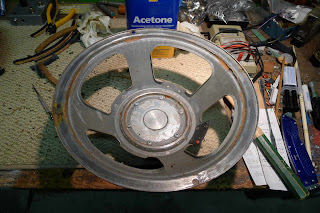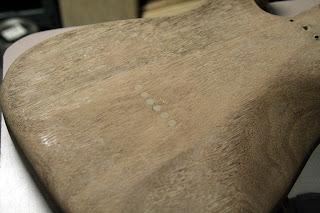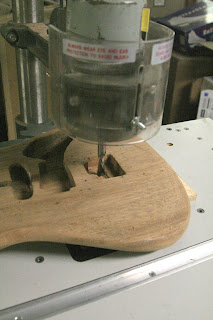Here are photos showing the process of refinishing a Fender Strat style guitar body with a
candy apple green nitrocellulose lacquer.
Original black paint job on mahogany body
Using paint stripper to remove old paint
Plugging old holes that will not be used
Neck mounting holes were way off so the old ones get plugged and correct holes
can be drilled
The old string through body holes are now plugged
Routing out the side jack so it can be plugged with a block of mahogany.
A standard top mount jack plate will be used instead of the side jack.
Plug of mahogany is fitted into the routed body
The plug has been shaped and the old screw holes plugged with wood from old q-tips.
The neck plate shape was not correct so a mahogany plug was inlaid
in order to get the shape corrected.
The plug after it is shaped to the correct form
The neck mounting plate now has enough wood beneath it under the lower left corner.
Prior to this correction the metal plate corner protruded out from the edge of the guitar body.
The pocket for the Kahler tremolo assembly is routed out for a better fit.
Initial wood removal for the top mount jack plate.
Top mount jack plate hole is routed out using a pin router table.
Fit check of the components prior to applying the wood pore filler goop.
Initial application of the wood pore filler. Note the color of the filler has had aniline dye
mixed to match a color appropriate for the mahogany.
Guitar body hung out to dry for a few hours prior to wiping off the excess pore filler.
Clear lacquer coats applied over the pore filled body.
See how the pore filled wood grain has a nice contrast against the mahogany.
Primer coat is sprayed over the body after the clear coats were sanded smooth.
Final coats of primer eventually cover the mahogany well enough to move on to the next
step of applying the gold metallic candy undercoat.
First coats of the gold candy metallic.
This photo shows the gold color most accurately.
A few coats of clear nitro lacquer are applied as a guard coat prior to applying the
green color coats.
Initial coats of the green over the gold.
The final color is achieved after 5 coats of the candy green are sprayed.
After this the body gets a good number of clear lacquer coats applied over a couple of days.
The clear coats are lightly sanded between coats if needed to remove any dust or runs.
The guitar is now given a few weeks to allow the lacquer solvents to out gas prior to giving the
finish a wet sanding session using sandpaper from 800 grit all the way up to 2000 grit.
I use soapy water or mineral spirits when I wet sand to keep the paper from gumming up with lacquer particles.
Here are shots of the assembled guitar after the finish gets rubbed out using a few Meguiars
auto finish polishing products.
































































